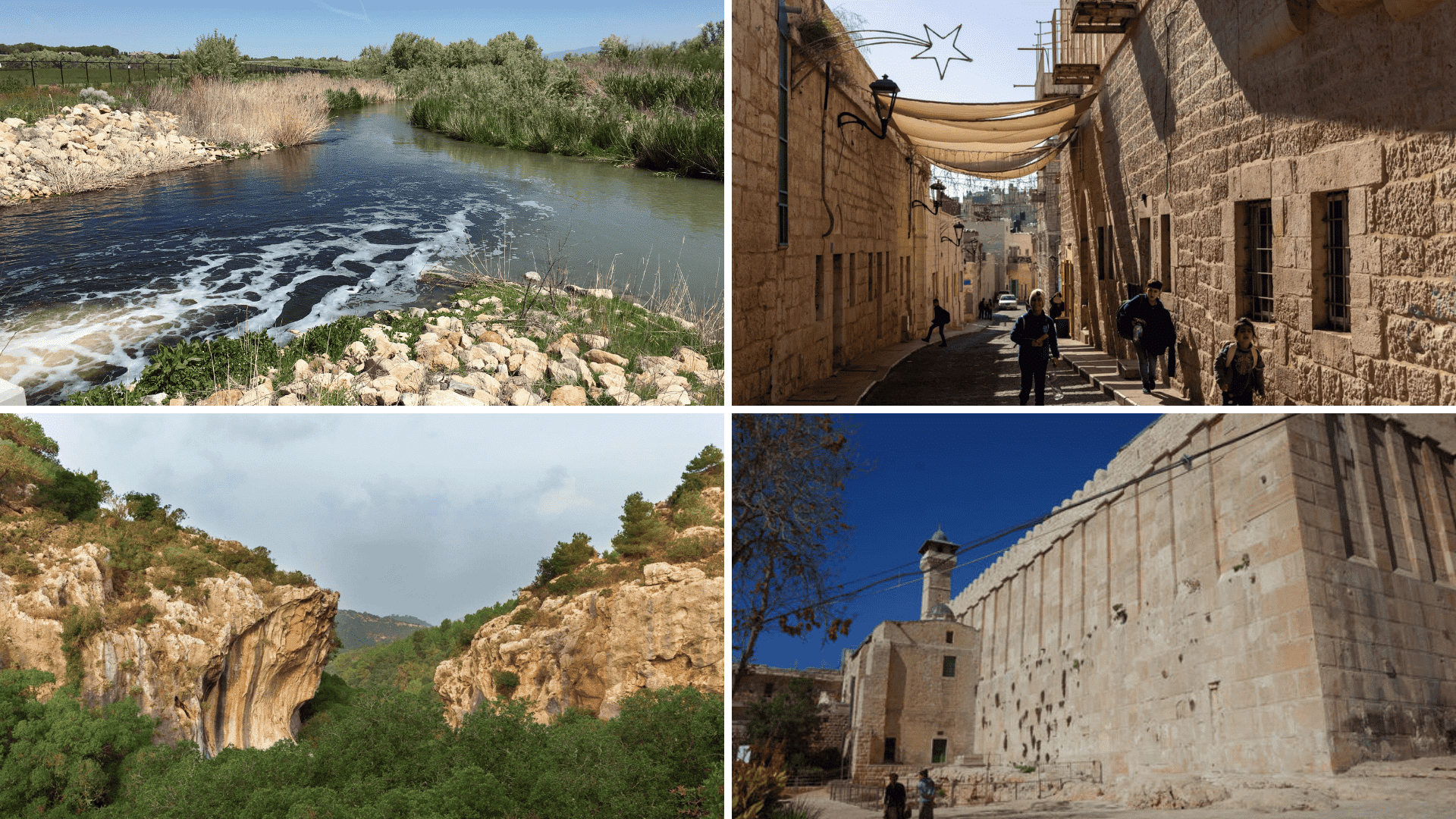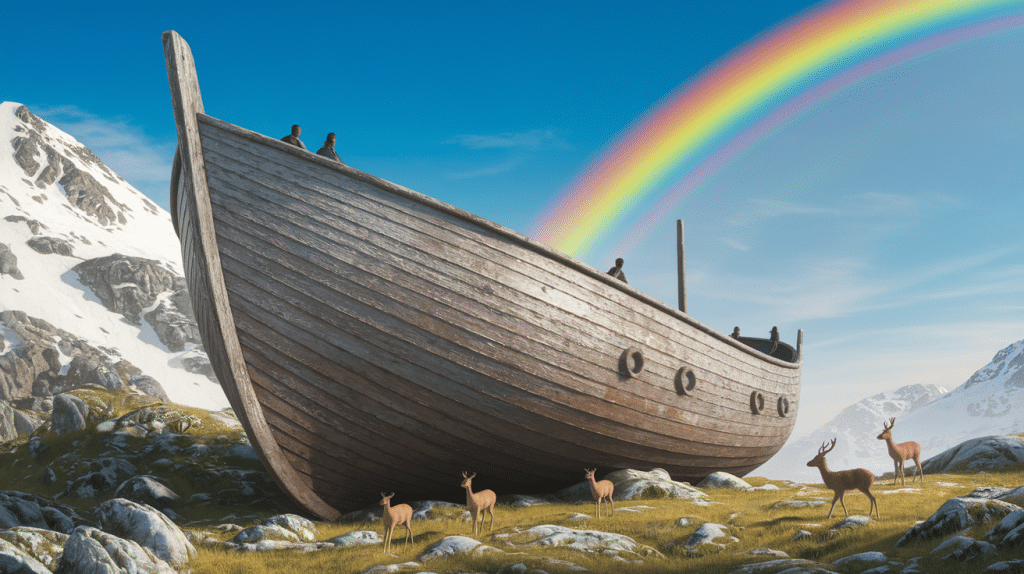The Bible is packed with incredible places where amazing things happened. Think about it – from the very first garden where Adam and Eve lived with God to the bustling streets of Jerusalem where Jesus changed everything forever.
These aren’t just random locations mentioned in old stories. They’re real places where people experienced God in life-changing ways. Every mountain, desert, and city played a part in shaping the faith we know today.
In this list of important biblical places, we’ll explore what made each location so special and why these stories still inspire us.
Key Biblical Locations and Their Significance

These places are the backdrop to some of the most powerful moments in the Bible’s unfolding story.
1. Garden of Eden
The first home for humans, where God placed Adam and Eve. This paradise had many trees, including the tree of life and the tree of knowledge of good and evil.
It was in this garden that sin first entered human history.
God stationed angels with flaming swords to guard the entrance, making it impossible for humans to return. The exact location remains unknown to this day. (Genesis 2:8-15)
2. Mount Ararat
The mountain where Noah’s ark came to rest after the great flood that covered the Earth. God sent rain for forty days and nights to cleanse the world of wickedness. (Genesis 8:4)
- After sending out birds to check for dry land, Noah and his family finally stepped out onto solid ground.
- God made a promise, marked by a rainbow, never to flood the whole earth again.
3. Ur of the Chaldeans
Abraham’s birthplace was in Mesopotamia (modern Iraq). In this ancient city, God called Abraham to leave his home and family to travel to an unknown land that would later be given to his descendants. (Genesis 11:31)
4. Bethel
A place where Jacob had a dream of angels going up and down a ladder reaching heaven. (Genesis 28:10-19)
- God stood above it and made promises to Jacob about land and countless offspring who would spread across the earth.
- Later, Jacob returned to Bethel, where God changed his name to Israel.
- This location became a key worship site.
5. Egypt
The nation where Joseph rose from slave to second-in-command, later taking in his family during a severe food shortage. The Israelites lived here for 430 years, growing from a family to a nation.
Through mighty signs and wonders, God rescued His people from Egyptian control under Moses’ leadership.
The exodus from Egypt became the defining freedom story in Israel’s history. (Exodus 1:8-14)
6. Red Sea
Moses holds out his staff, and God miraculously splits the Red Sea to allow the Israelites to escape from the Egyptian army. (Exodus 14:21-29)
- With water standing like walls on both sides, the people walked across on dry ground to safety.
- The crossing became a turning point in Israel’s history, marking their complete break from Egypt.
- It showed that God controls nature and uses it to carry out His plans for His people.
7. Mount Sinai
The mountain where God gave Moses the Ten Commandments and made a promise with Israel. God came down in fire and smoke, causing the mountain to shake while the people waited below.
At this mountain, the people agreed to follow God’s rules, saying, “All that the Lord has spoken, we will do.” (Exodus 19-20)
8. Jericho
The first city the Israelites faced when they entered the Promised Land. God told Joshua to march around the city for six days, then seven times on the seventh day, after which they should shout.
In this city, Rahab hid Israelite spies and was later saved along with her family when the city was taken. (Joshua 6:1-25)
9. Jordan River
The river marked the eastern border of the Promised Land, which God miraculously stopped flowing, so the Israelites could cross.
The priests carried the Ark of the Covenant into the river first.
Joshua set up twelve stones from the river as a monument so future people would remember what God had done.
This crossing marked the official entry of Israel into its promised home. (Joshua 3:14-17)
10. Shiloh
The place where the Tabernacle and Ark of the Covenant were kept after Israel settled in Canaan.
- For about 300 years, this was the main worship center for all Israelite tribes.
- Shiloh lost its status when the Philistines captured the Ark in battle.
The town was likely destroyed, becoming a warning example of what happens when God’s presence leaves a place. (1 Samuel 1:3)
11. Bethlehem
The birthplace of King David and later Jesus Christ. This small town in Judah became famous beyond its size because of these two key births in Bible history.
Mary and Joseph came here for a Roman census of the people, fulfilling the old prediction about where the Messiah would be born.
Angels announced the birth to shepherds watching their flocks in nearby fields. (Micah 5:2, Luke 2:1-7)
12. Jerusalem
The capital city of Israel was established by King David, who brought the Ark of the Covenant here. (2 Samuel 5:6-10)
- This city, built on hills, became the center of Jewish national and religious life.
- Jesus taught, did miracles, died, and rose again in this city.
- The early church began here at Pentecost. Both Jewish and Christian traditions see this city as having special meaning.
13. Temple Mount in Jerusalem
The hill where Solomon built the first Temple, following the plans his father, David, had received.
- This building, with its gold coverings and fine workmanship, housed the Ark of the Covenant.
- Jesus visited this place often, teaching in its courtyards and clearing out those doing business there.
He predicted its destruction, which happened in 70 AD when Roman forces took the city. (1 Kings 6)
14. Mount Carmel
The mountain where Elijah faced off against 450 prophets of Baal in a contest to prove whose god was real. Each side prepared a sacrifice but didn’t light it, asking their god to send fire.
This showing of God’s power led the watching people to fall down and say, “The Lord, He is God!” (1 Kings 18:16-40)
15. Nineveh
The capital city of Assyria, where God sent Jonah to warn about coming judgment. Jonah tried to run away but was brought back by being swallowed by a huge fish and then spit out on land.
God saw their change of heart and did not destroy the city as planned.
This upset Jonah, who wanted the city punished, showing his lack of care for people unlike himself. (Jonah 3:1-10)
16. Babylon
The mighty city that captured Jerusalem and took many Jews into exile for 70 years. This time away from their homeland tested the Jewish people’s faith and changed how they practiced their religion.
When Persia defeated Babylon, King Cyrus allowed Jews to go back to Jerusalem.
However, many stayed in Babylon, creating lasting Jewish communities outside the promised land. (Daniel 1:1-7)
17. Capernaum
A town by the Sea of Galilee that became Jesus’ base during much of his teaching work.
- Jesus did many healing acts here, including curing a Roman officer’s servant and a disabled man lowered through a roof.
- In the synagogue of this fishing town, Jesus gave his famous speech about being “the bread of life,” which confused and upset many of his followers.
The ruins of this town’s synagogue can still be seen today. (Matthew 4:13, 11:23)
18. Sea of Galilee
A freshwater lake where Jesus spent much time with his disciples, many of whom were fishermen. (Matthew 8:23-27, John 21:1-14)
- On these waters, Jesus calmed a strong storm with just his words, amazing those with him.
- After his return to life, Jesus met seven disciples fishing on this lake and cooked breakfast for them on the shore.
- During this meal, he asked Peter three times if he loved him.
19. Mount of Beatitudes
The hill where Jesus gave his famous Sermon on the Mount. In his speech, Jesus turned common thinking upside down by saying that the happy ones are the humble, the sad, and those wanting the right way.
He told people not to worry, not to judge others harshly, and to ask God for what they need.
He ended with the story of two house builders, showing the importance of actually doing what he taught. (Matthew 5-7)
20. Nazareth
The town where Jesus grew up was after his family returned from Egypt. This small place in Galilee was looked down on by many Jews. (Luke 4:16-30)
- The crowd tried to throw Jesus off a cliff, but he walked through them safely.
- After this, he did not spend much time in his hometown, focusing his efforts on more open-minded places.
21. Samaria
A region between Judea and Galilee whose people were looked down on by Jews due to their mixed background and different worship practices.
- Most Jews would go around this area when traveling.
- In the story of the Good Samaritan, Jesus used a man from this area as the hero who helped a hurt Jewish man when religious leaders passed by.
This challenged the hatred between the groups. (John 4:1-42)
22. Pool of Bethesda
A water pool in Jerusalem where sick people gathered, hoping to be healed when the water moved. Jesus met a man here who had been unable to walk for 38 years.
The man was healed at once, but religious leaders focused on the fact that he carried his mat on the Sabbath rest day. This act on the Sabbath added to the growing anger toward Jesus from the religious system. (John 5:1-15)
23. Gethsemane
A garden on the Mount of Olives where Jesus prayed before his arrest. In deep mental pain, knowing what was coming, Jesus asked if the cup of suffering could be taken away.
Judas led soldiers to this garden, marking Jesus with a kiss to show which man to arrest.
Peter tried to fight back with a sword but was stopped by Jesus, who healed the ear of a high priest’s servant. (Matthew 26:36-56)
24. Golgotha
The hill outside Jerusalem where Jesus was killed on a cross. (John 19:17-30)
- Called “the place of the skull,” this spot along a road allowed many people to see the punishment and mock the one being killed.
- Darkness covered the land for three hours as Jesus suffered.
- With his final words, “It is finished,” Jesus completed his task of paying for human sin before giving up his spirit.
25. Garden Tomb
After Jesus died on the cross, his body was put in a rock chamber that belonged to Joseph of Arimathea, who was a hidden follower and part of the Jewish council.
After three days had passed, women came to complete the proper burial care. They found the stone moved away and the burial space empty.
Angels told them Jesus had come back to life, exactly as he had said would happen. (Matthew 27:57-60, 28:1-8)
26. Emmaus
A village about seven miles from Jerusalem, where two followers met the risen Jesus while walking home after Passover. They did not know who he was as he joined their sad conversation.
Only when Jesus blessed and broke bread at their dinner table were their eyes opened to see who he was.
Just then, he disappeared from their sight, causing them to rush back to Jerusalem with the news. (Luke 24:13-35)
27. Damascus
The city to which Saul was heading when Jesus appeared to him in a bright light, changing his life’s path. Saul was going there to arrest followers of Jesus, but instead became one himself. (Acts 9:1-22)
- Saul, later called Paul, began telling others about Jesus in this same city where he had planned to stamp out the faith.
- This change from chief enemy to key supporter shocked the early church.
28. Hebron
Hebron was a key city in the Old Testament. Abraham settled here and bought a cave (Machpelah) to bury his wife, Sarah. Later, Isaac, Jacob, Rebekah, and Leah were also buried there. (Genesis 23:1-20)
This city represents God’s covenant with Abraham about giving the land to his descendants. It was also David’s first capital before Jerusalem and symbolizes the deep historical and spiritual roots of the Jewish people.
29. Mount Tabor
Traditionally considered the site of the Transfiguration, where Jesus’ appearance changed, and he talked with Moses and Elijah. (Matthew 17:1–9)
- This mountain scene revealed Jesus’ divine glory to Peter, James, and John.
- God’s voice declared Jesus as His beloved Son, confirming his identity and mission.
- It was a moment of divine confirmation and preparation for the road to the cross.
30. Caesarea Philippi
Jesus took his disciples to this pagan city near Mount Hermon. Here, Peter declared, “You are the Messiah, the Son of the living God.” (Matthew 16:13-20)
This bold confession of faith became a foundation moment for the early church. Jesus replied, “On this rock I will build my church,” indicating that Peter’s faith (or Peter himself) would be central in spreading the gospel.
31. Patmos
The Apostle John was exiled to this small Greek island during Roman persecution. While there, he received the visions that became the Book of Revelation. (Revelation 1:9)
Though isolated and imprisoned, John experienced powerful revelations from God about the future, the return of Christ, and ultimate victory over evil.
Patmos reminds us that even in hardship and isolation, God can speak and reveal His purposes. It’s a symbol of hope, endurance, and divine communication in dark times.
The Bottom Line
These biblical places remind us that our faith has real roots in history. From mountaintops to city streets, God chose to work through actual locations where real people lived, struggled, and found hope.
When we read about these places today, we’re not just learning ancient history. We’re connecting with the same God who still works in our neighborhoods, our homes, and our daily lives. These sacred locations prove that God doesn’t stay distant; He enters our world and meets us exactly where we are.
The stories continue, and the places where faith happens are all around us.















